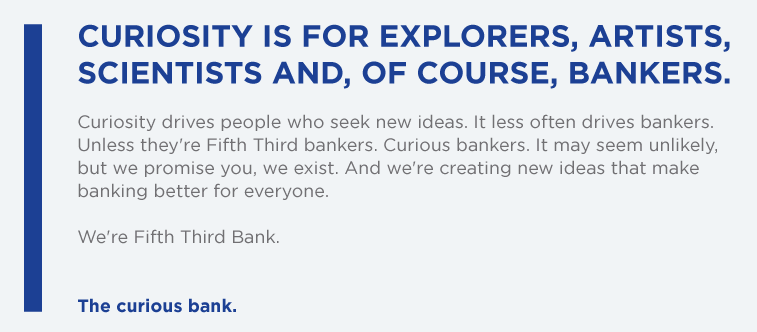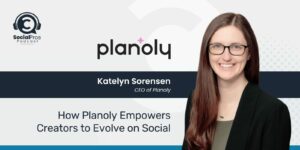Hosted By
About Social Pros Podcast:
Social Pros is one of the longest-running marketing podcasts in existence (10 YEARS and counting), and was recently recognized as the #1 Audio/Podcast Series by the Content Marketing Awards.
Our purpose? Making sure that we speak to real people doing real work in social media.
Listeners get inside stories and behind-the-scenes secrets about how teams at companies like Google, Reddit, Glossier, Zillow, Lyft, Marvel, and dozens more, staff, operate, and measure their social media programs. With 600+ episodes, the Social Pros Podcast brings the humanity of social media to the forefront, while providing incredibly useful marketing strategies that listeners can immediately implement.
Follow Social Pros on LinkedIn.
To inquire about becoming a guest or show sponsor, please email our Executive Producer, Leanna Pham, at leanna@convinceandconvert.com.
Apple Podcast Reviews:
The Social Pros podcast has quickly become a favorite in my feed! I'm consistently impressed by the engaging conversations, insightful content, and actionable ideas. I truly learn something every time I listen!
@Arlie KThis is absolutely an awesome listen for anyone in communications or social media!!
@Will31CThis podcast has become one of my staple weekly podcasts for learning about marketing! Love the conversations that they have and it's always enjoyable and educational!
@Simonstone95Love the podcast - informative, in depth and spot on for any business size.
@MissTriathlon
Shannon Paul, VP of Social Media Strategy at Fifth Third Bank joins the Social Pros Podcast this week to discuss her new role at the bank, what it’s like to start a brand new social media strategy at a bank, and how listening, sentiment, and share of voice play into overall success metrics in the banking […]

Shannon Paul, VP of Social Media Strategy at Fifth Third Bank joins the Social Pros Podcast this week to discuss her new role at the bank, what it’s like to start a brand new social media strategy at a bank, and how listening, sentiment, and share of voice play into overall success metrics in the banking industry.
Read on for some of the highlights or listen below for the full podcast.
Listen Now
Click the play button to listen here:
[podcast]http://socialpros.podbean.com/mf/web/f96a8c/SocialProsEpisode40.mp3[/podcast]
Download the audio file:
http://socialpros.podbean.com/mf/web/f96a8c/SocialProsEpisode40.mp3
The RSS feed is: http://feeds.feedburner.com/socialprospodcast
Find us on iTunes: http://itunes.apple.com/us/podcast/convince-convert-blog-social/id499844469
Please Support Our Sponsors
Huge thanks to data-driven social media management software company Argyle Social for their presenting sponsorship, as well as Infusionsoft, Janrain, and Jim Kukral at DigitalBookLaunch. We use Argyle Social for our social engagement; we use Infusionsoft for our email; Janrain is our crackerjack social integration company, and Jim is our guest host for the podcast (and a smart guy).
Social Pros Highlights For Your Reading Enjoyment, Thanks to Speechpad for the Transcription
Understanding Organizational Structure Before Social Strategy
Jay: Thanks again for being with us today, Shannon. In addition to getting to know the city, you’re getting to know a new organization. Coming into Fifth Third Bank, which had some social initiatives started from Michael Ruben, who was there previously. What’s that like for you? You show up, “Hi, I’m Shannon, I’m going to take over now.”
When you come into a major organization like that, what do your first hundred days look like? How do you even get started?
Shannon: I’ve joked around before. Even before here, I was at Blue Cross Blue Shield of Michigan, and if anybody has actually gone through the process of actually adding a social media position, there’s likely some stuff that’s either been generated, been reported. They may have a social profile or two hanging out there.
I’ve joked in the past that I’ve had to create a triage unit and test for signs of life, and to see what here has legs, what should we prioritize. Really at this stage of my career I’m getting much more high level and involved in strategy.
The first hundred days I really devote to trying to learn as much as I can about the organization and my peers throughout the organization as I can, simply because a key driver in any successful strategy is going to be organizational and operational alignments. I can’t really create a strategy that aligns with the organization and various areas of operations if I don’t understand it.
Jay: Not just the organization, but banking and its unique proclivities and circumstances as well. I know you did some level of work in financial services when you were in Seattle, but retail banking I suspect is a whole different animal.
Shannon: It is and it isn’t. In some ways I think consumers are consumers. Maybe that can be a little bit controversial. I think that it’s important to get to know people, but it’s important to get to know all people. Before we start trying to talk to them or connect with them, we have to get to know them and who they are.
 To some extent, consumers are consumers. Really, while there’s certainly a lot of other layers of rules and everything in a regulated industry, I think all businesses have rules. We can’t just say whatever we want and do whatever we want. Franchises have brand guidelines, you have lawyers.
To some extent, consumers are consumers. Really, while there’s certainly a lot of other layers of rules and everything in a regulated industry, I think all businesses have rules. We can’t just say whatever we want and do whatever we want. Franchises have brand guidelines, you have lawyers.
I think that’s an important part of any business is understanding the landscape and the things that you’re supposed to comply with. Facebook has terms of service. We have to figure out how to balance all those competing rules or layers of rules and then figure out how we’re going to navigate them and connect with the people we’re going to connect with.
Jay: Well said. What does your team look like there?
Shannon: Today it’s me. You’re talking to my team.
Jay: Awesome. Make sure you’re in a secure location. Nothing can happen to you. Are you calling from a bunker, is that the way this works? A special bunker?
Shannon: Yeah. I tend to be in start-up mode, that’s just how it is. It was this way at Blue Cross when I was there, it was this way when I started at Peak6, when I was at the Red Wings I was a party of one.
Jay: You like it that way, right? As soon as you need another hire you’re like, “I quit. If we get big enough that I need another person, I’m out.”
Shannon: Right. By the time I left Blue Cross, we had a team of five.
Jay: Okay, I take it back.
Shannon: I was there for two years, and I think we were able to grow the team in a really smart way. We worked with an agency of course, and I think that’s actually key whenever you don’t have a team, you can get an agency on board to help with the heavy lifting.
As much as people like to think that this is a rockstar position in the company, I don’t get it. I figure much of my time is devoted to learning rules and developing processes, because you really just have to figure out, how are we going to document this?
The biggest point of pride I think I’ve had in my career is being able to walk away from Blue Cross and look at it go and say, “Look at all this that’s able to happen without me now.” It’s a sustainable program.
Jay: Yeah, you built a car and other people are driving it now.
Shannon: Yeah. I swell with pride when I look at what they’re doing today and the team that’s in place there.
Jay: What is Fifth Third trying to accomplish in social? What is your strategic direction, and how is this plusing up the business?
Shannon: We are all about listening. That’s key. Really strategically, I think most of that is really coming into the shape right now. I’m about three months in, so I don’t think I’m going to be able to divulge a lot, but it really is about listening and extending our brand into these social places.
I think it’s important that companies in regulated industries like banking and healthcare be very accessible. I think it’s important that we be communicative and transparent, and all the things that social media lends itself to.
Social vs. Traditional Customer Service in Action
Jay: I know there’s some Twitter customer service initiatives. I’ve certainly seen Fifth Third answer customer questions via Twitter. Is that part of the program, and one of the tent poles of what you’re trying to accomplish? Who is in charge of actually executing on that?
Shannon: Well, it’s a partnership. We have a partnership with our customer service team. We have a dedicated resource that it’s his job, he watches out for what we consider to be customer service recovery missions. He reaches out to people, and we have an 800 number that’s dedicated for that purpose.
When people are found that need an issue, that have a customer service issue that we think we can resolve, he reaches out and offers that number, and then when people dial they get him, so he’s able to help get them in the system.
It’s a partnership. Of course we do have somebody who’s dedicated to that, but I also help provide some context. We have a fairly rigorous approval process, everything that we say in social media has to be approved by legal compliance. I work with him sometimes to get responses through that process, and figure out can we really investigate? I bounce things off of him, or I ask him if we know the history. We work together as a team.
Jay: In terms of that legal approval, does that have to be done at the individual piece of content level, or can you or do you have proposed responses pre-approved by legal that you can say, “All right, in this circumstance we say this and legal has already blessed that particular response.”
Shannon: It’s both. We do as much as we can on the front end to get things that are already pre-approved. I love using an example when I started working at the Red Wings, this is always my key example on why the FAQs only get you so far. That’s when I created the team’s Twitter account, the first question that I got from a fan on Twitter was, “What is the view from the wheelchair seats like?”
They didn’t ask where are the wheelchair seats. They asked what the view was like. Because really this investigative process wasn’t established…
Jay: You had to go get a wheelchair, you had to get a camera, the whole process.
 Shannon: I had to call the 800 number and I had to ask a ticket agent where the section was, then locate the section on the map, go get security because it was a time when the arena was closed, and ask them to take me up there where they usually seat the wheelchairs. Then he didn’t ask me where it was, he asked me what the view was like, so I snapped a photo of the ice from that location and shared it with him on Twitter.
Shannon: I had to call the 800 number and I had to ask a ticket agent where the section was, then locate the section on the map, go get security because it was a time when the arena was closed, and ask them to take me up there where they usually seat the wheelchairs. Then he didn’t ask me where it was, he asked me what the view was like, so I snapped a photo of the ice from that location and shared it with him on Twitter.
It’s like as much as we try to anticipate what people are going to ask or how they’re going to ask things, we’re human, we’re unpredictable, or we have three part questions. Some of it might recall an episode that happened two years ago, but they’re just now talking about it now because something happened the other day. We’re complex.
Jay: As soon as this podcast is over I’m going to tweet Fifth Third Bank with the question, “What are ATMs made out of?”
Shannon: Oh, please don’t.
Jay: We’re going to see how that works.
I’m glad you mentioned listening a moment ago. I think for anybody who’s been doing social media for a while it’s almost a rule of thumb, it’s almost a tautology at this point. Yet I find that a lot of companies say, “Yeah, yeah, yeah, we’re doing listening,” but they’re really not. They’re listening for exact mentions of the brand, and then they’ll try and respond in a customer service context.
There’s a difference I think between “listening at the point of need” as Amber Naslund would say and Radian6 would say versus “proactive aggressive listening” to pull customer insights out and connect the dots. It sounds like you’re trying to do more of the latter.
Shannon: Yeah. Listening is more a part of our brand position, of the Curious Bank. We are The Curious Bank, and that means being better listeners, we have better solutions, better ideas and better commitment. It means this is something that really permeates the organization.
When I talk about listening, and yes, it’s about hearing people and responding, but it’s also about using social media to become part of the intelligence of the organization. It’s just another way that people talk about us. I’m really big on making sure that the insights are delivered to various areas of the company in ways that are usable to them.
If they’re tagging phone calls to classify them in certain ways, I don’t need to create a new classification system for social media. I should probably use their classifications, so that when I deliver insights to them they make sense and they’re actionable.
Jay: Those insights are delivered parallel then. You say “on this particular topic, we have customer feedback that has been collected via phone as well as customer feedback collected via social.” Right? It’s a categorical split as opposed to a channel split.
Shannon: Then we can compare apples to apples.
Jay: Interesting. When you say you try to batch those up for each part of the enterprise, it’s really interesting. Does that mean that actually functionally you go in and make different reports for each person and then interpret those reports and say, ‘Hey, Julie in product marketing, this is what this means.’
Shannon: Sometimes. I think on a regular basis, it’s just about trying to provide a snapshot that is going to serve the needs of various parts of the organization. Then we can do deep dives if we’re doing any kind of a product kick-off. We’ve got the capability to do some research that way.
The regular reports are just with key areas of the business that we work with on a regular basis, getting that established.
Jay: Have you had to or wanted to change the software and technology that you are applying to social at Fifth Third since you came in? Have you said, “OK, you know what, we need to get some different tools in here”? Or have you said, “All right, we’ll play the hand we’ve been dealt” when you arrived?
Shannon: I think there’s a little bit of both. There’s contracts and things that that exist. You have to ride those out. When I think about growing long term, we’re definitely looking at things that will help us scale over time. You can’t just overhaul everything in one day, especially in a regulated industry. You’ve got a lot of Is to dot and Ts to cross when you go through something like that. There are a lot of layers of approvals and just making sure that we’re partnering with areas in the company that assess risk and IT requirements, all that other good stuff.
Jay: Yeah, good times.
Shannon: It’s my life.
Measuring Sentiment in Social Media
Jay: Because retail is pretty competitive, right, there’s a lot of banks really everywhere, but it seems to me more so in the Midwest than other places. That could be not true, maybe that’s just my perception since moving to the Midwest. Do you play a lot of attention to directional metrics like Sentiment and Share a Voice?
Shannon: Share a Voice is probably tricky. Sentiment’s very important.
 One of my wishes for Sentiment trackers was to create something that’s manual. Like I said, having people talk about how much they love the hot dogs at Fifth Third Field is great, and great for our brand, but it doesn’t necessarily tell us what we need. It doesn’t provide the kind of insight that we need whenever we’re really determining consumer sentiment around banking with us.
One of my wishes for Sentiment trackers was to create something that’s manual. Like I said, having people talk about how much they love the hot dogs at Fifth Third Field is great, and great for our brand, but it doesn’t necessarily tell us what we need. It doesn’t provide the kind of insight that we need whenever we’re really determining consumer sentiment around banking with us.
Yes, I think it’s still important. I don’t want to throw it out. I don’t want to have to filter it out. I want that there, I just don’t want it tainting the positive or negative. I’d rather be able to actually manually set how you determine positive or negative is still something that the industry is lacking.
You can always correct me if I’m wrong. I know you’re looking at these tools all the time.
Jay: No, it exists out there. It’s possible in certain platforms, but the challenge is that most of the platforms that have that layer of complexity are built at enterprise scale where, even if you wanted to manually score it, there’s too many mentions to really make that practicable. It falls apart.
We were talking to Rick Wion last week from McDonald’s. They have tens of thousands of social mentions every day. Nobody is going to sit there and hand score all those. It just doesn’t make any sense, and I think sometimes the software business tends to coalesce into two camps. It tends to coalesce into an enterprise camp, which is let’s do whatever we can to make sure that McDonald’s uses us, so we build that size of a solution. Or it’s small business, really inexpensive, let’s get the mass market.
What happens is the mid-sized company doesn’t really have a solution tailor made for their world. I think that’s what we’re seeing right now in the social software business. There’s great big company solutions and there’s great affordable company solutions, and the guy in the middle has a tough time either affording the big solution or getting the functionality they need out of the small guys.
Shannon: That makes sense.
Jay: The other thing that bugs me from a Share a Voice perspective is that, in a circumstance like yours where you’re a regional bank competing in some cases against national banks, when you start running the Share a Voice report versus Bank of America, you’re going to lose that fight just on volume.
You say, okay, we’ll only put a geography around Bank of America mentions. The challenge is that not many people put geography around their social media posts. It’s a very unreliable filter.
Shannon: Yeah, no, that’s a very good point. I think that’s something that companies of all sizes are going to struggle with, is the geo issue. We don’t want to be posting irrelevant content for people who are maybe outside of that community, but also we’re proud of our community activities. It’s certainly a lot to consider there.
Jay: Last question before we take a quick break for some sponsor reads and I’ll be back with stat of the week. Tell me now that you’ve been there a hundred days, what does Fifth Third Bank mean? As a customer, I don’t even know what it means. It’s the fraction bank.
Shannon: Right. It is on our website. We do have an explanation.
Jay: Why would I go to a website when I can just ask you?
 Shannon: I know, I know. Well, long story short is that there was a merger. The Fifth National Bank and Third National Bank of Cincinnati merged, and they didn’t really want to become one or the other so they kept both.
Shannon: I know, I know. Well, long story short is that there was a merger. The Fifth National Bank and Third National Bank of Cincinnati merged, and they didn’t really want to become one or the other so they kept both.
Jay: Then you can’t be Third Fifth Bank, because it feels like you’re not a full bank, right? You’re a fraction of a bank. It has to be Fifth Third. Third Fifth wouldn’t make any sense at all.
Shannon: Yeah, three-fifths. There’s some myths out there about why it’s not three-fifths. Anyway, it’s Fifth Third. Yeah.
Jay: And a great domain name, 53.com. Cannot forget it. The shortest domain name I use regularly, I’ll tell you that right now.
Shannon: Yeah, it is nice that it’s that short. Not a lot of typing.
Social Media Stat of the Week: 10 Instagram Photos Per Second Posted During Superstorm Sandy
Jay: All right, Shannon. Now is the time, the special time of the week. Usually Eric does this, but he is gone, so I’m going to take over his section. Which is called the Social Media Stat of the Week.
This week the social media stat of the week is that during the big Hurricane Sandy, it has been reported that there were as many as ten Instagram photos per second being posted about Hurricane Sandy.
I mentioned this on Twitter yesterday. It seems to me like this is going to go down in history, not only as a great tragedy of course, but as the event that pushed Instagram to a new level of respectability as a news source. It became a real thing, not a frivolous “Hey, look at my toes in the sand on the beach,” but a citizen reporting kind of a thing. It’s a big moment I think in the evolution of that company. What do you think?
Shannon: Are you asking me?
Jay: I am asking you.
Shannon: I think that yeah, I saw quite a bit from the streams on Instagram. I think what was really interesting to me was how much controversy there was over the Photoshopped images on mainstream news sites. People were saying that the feed from Instagram was much more reliable.
I think that’s really the first time I think that, and maybe it’s not the first time, but it calls to question what’s the more reliable source whenever you’re in an emergency situation or you have people who are watching out for loved ones who could possibly be impacted. I know my sister-in-law lives in Philadelphia, and I was paying attention to her Facebook updates to make sure they were OK.
It is definitely one of the terrific impacts that social media has had on the way that we connect with each other.
Jay: Yeah. We’ve always thought of Twitter as that go to technology, global watercooler kind of a moment. That’s still true, but I really felt for the first time yesterday that I was going through the Twitter feed, purposefully looking for Instagram photos.
I thought just strategically. In this circumstance Twitter is just the delivery vehicle. They’re just a vessel, and it’s really all about the content being created on Instagram. The content’s not being created on Twitter, Twitter’s just a delivery mechanism.
I thought strategically you play that out over time, and the emergence of photos and videos over the written word, I think there’s no question that’s the direction we’re all headed, because Johnny don’t want to read anymore.
I just thought there’s something here, and when Facebook bought Instagram I thought that seems like an awfully expensive defensive gesture, but now I start thinking maybe there’s a method to the madness there. Maybe they feel like Instagram, because it’s got a photo, can maybe… supplant Twitter is too strong, but certainly give them a run for their money.
Shannon: Yeah. You’ve got to think that showing a photo of six inches of flooding is certainly different than saying it.
Jay: “There’s six inches of flooding.” Sure, yeah.
Picture’s worth 140 characters.
Shannon: Right, right. Not only that, I think it’s interesting that people were actually applying filters to their flood images.
Jay: “Let me show you just how bad this is in black and white.”
Shannon: Does this look better with Hefe or Nashville?
Jay: Right, right. Ten Polaroid. This is a truly shocking image.
Shannon: Right, right.
Jay: Yes, that actually is an interesting trend. You feel the need to filter your hurricane devastation photo.
Shannon: Yeah.
Jay: Once it’s okay to joke about it, which will be quite a while, there will be a Tumblr blog about that. I guarantee it.
Shannon: Yeah, there could be. I wasn’t seeing any people taking stills of themselves in the bathroom shot with flooding behind them.
Jay: Yeah. I’m sure it happened.
Shannon: Probably.
Social Pros Shoutout
Jay: All right, it is time for the Social Pros shout-out. Where you, Shannon Paul, the guest on the show, clue people in to somebody, a real person doing real work in social media who does not get the attention he or she deserves. Who do you have for us?
Shannon: I think the first one I should probably say is Dave Murray. He’s also a fellow Detroiter, but he assumed my former position at Blue Cross Blue Shield of Michigan. He’s an all around great guy.
Jay: Great guy, I concur.
Shannon: Yeah, they’re lucky to have him. Give a shout-out to Dave Murray. Then if I could say one more, probably Kristy Bolsinger, another one of my friends that I met from my Seattle days.
Jay: What does she do?
Shannon: She’s a senior associate at Pricewaterhouse Coopers, previously with Ants Eye View, an interactive agency.
Jay: Oh, great.
Shannon: Yeah. She’s @Kristy, so she’s one of the lucky people to have just one name on Twitter.
Jay: Well played. Well played. Nice, I love Ants Eye View. I don’t think I’ve met Kristy, maybe I have. I don’t think so, but I love the folks at Ant’s Eye View, doing great work. Those are both good Social Pros shout-outs. Thank you very much.
It was awesome to catch up with you and have you on the show. I really appreciate your time. Keep up the good work at Fifth Third. If I have any issues balancing my checkbook, I will be in touch.
Next week on the show Eric will be back presumably, and we are going to have Jodi Gersh, who does social media for Gannett Newspapers. All kinds of interesting stuff going on with those guys, not only the local papers here in Indiana and in Arizona and around the country, big changes at USA Today, all kinds of stuff. We’ll ask Jodi about that next week on Social Pros.
Until then, thanks very much to everybody for listening, for talking up the show on social media. Make sure you download it on iTunes, tell your friends, all that jazz. Thanks very much.
See you next week!









